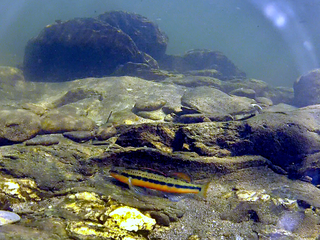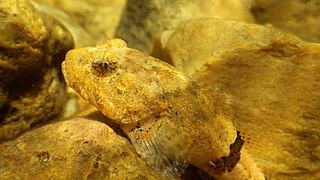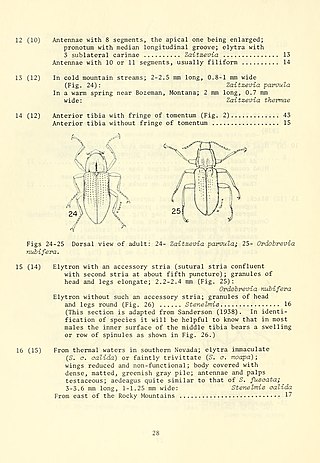
The sauger is a freshwater perciform fish of the family Percidae that resembles its close relative, the walleye. The species is a member of the largest vertebrate order, the Perciformes. It is the most migratory percid species in North America. Saugers have two dorsal fins; the first is spiny and the posterior dorsal fin is soft-rayed. Their paired fins are in the thoracic position and their caudal fin is truncated, which means squared off at the corners, a characteristic of the family Percidae. Another physical characteristic of saugers is their ctenoid scales, which are common in advanced fishes. Saugers have a fusiform body structure, and as a result are well adapted predatory fishes and are capable of swimming into fast currents with minimal drag on their bodies. They may be distinguished from walleyes by the distinctly spotted dorsal fin, by the lack of a white splotch on the caudal fin, by the rough skin over their gills, and by their generally more brassy color, or darker color in some regions. The typical sauger is 300 to 400 g in weight.

The leopard darter is a species of freshwater ray-finned fish, a darter from the subfamily Etheostomatinae, part of the family Percidae, which also contains the perches, ruffes and pikeperches. It is native to the United States, where it can be found only in the Little River drainage in Oklahoma and Arkansas. Its typical habitat is medium to large streams with rubble and boulder substrate. It feeds on small invertebrates on the riverbed and spawns mainly in March and April. It is threatened by impoundment, habitat loss and runoff from agricultural activities. It has never been a common species and has been listed as a threatened species in the United States since 1978, and the International Union for Conservation of Nature lists it as a "vulnerable species".

Redband trout are a group of three recognized subspecies of rainbow trout. They occur in three distinct regions in Pacific basin tributaries and endorheic basins in the western United States. The three subspecies are the Columbia River redband trout, the McCloud River redband trout and the Great Basin redband trout.

The amber darter is a small, endangered species of freshwater ray-finned fish, a darter from the subfamily Etheostomatinae, part of the family Percidae, which also contains the perches, ruffes and pikeperches. It is native to the Conasauga River and Etowah River in Georgia and Tennessee in the United States. It typically inhabits riffle areas over gravel and sand bottoms, hiding in aquatic vegetation when present. It feeds on small invertebrates and probably breeds between late fall and early spring. It is an uncommon fish with a small range and the International Union for Conservation of Nature has classified its conservation status as being "endangered".

The tangerine darter or river slick is a small species of freshwater ray-finned fish, a darter from the subfamily Etheostomatinae, part of the family Percidae, which also contains the perches, ruffes and pikeperches. It is found in the eastern United States. It grows to a length of 4.3 to 7.1 inches, males being bright orange-red while females are yellow. It is insectivorous, picking insect larvae off aquatic plants and the riverbed, and sometimes rolling small stones over to expose prey. It breeds in late spring and early summer, typically in shallow sandy or gravelly riffles. Pollution and habitat degradation may be a problem in parts of its range, however it is a fairly common fish with a wide range and the International Union for Conservation of Nature has classified its conservation status as being of "least concern".

The Roanoke logperch is a species of freshwater ray-finned fish, a darter from the subfamily Etheostomatinae, part of the family Percidae, which also contains the perches, ruffes and pikeperches. It is found in the Roanoke and Chowan drainages in Virginia and North Carolina in the United States. It inhabits low and moderate-gradient streams and rivers in warm, clear water in mostly unsilted gravel and rubble in runs, pools, and riffles. It is primarily insectivorous. This fish is a federally listed endangered species.

The Hawaiian hoary bat, also known as ʻōpeʻapeʻa, is a species of bat endemic to the islands of Hawaiʻi. Whereas the mainland hoary bat is found throughout North America, the Hawaiian hoary bat is distributed only among the major volcanic islands of Hawaiʻi, making it the only extant and native terrestrial mammal in the state; although some studies also posit that the mainland hoary bat lives in sympatry on the Hawaiian Islands alongside the Hawaiian hoary bat, this has been disputed. The Hawaiian hoary bat was officially named the state land mammal of Hawaiʻi in 2015. It is a federally listed endangered taxon of the United States.

The Maui ʻalauahio, also known as the Maui Nui ʻalauahio or Maui creeper, is a species of Hawaiian honeycreeper. It is endemic to Maui Nui, Hawaii. The name Maui ʻalauahio is somewhat misleading because the species seems to have occurred on most, if not all, parts of the ancient Maui Nui, which includes the present day islands of Maui, Molokaʻi, Lānaʻi, and Kahoʻolawe. There are two subspecies: the Lānaʻi ʻalauahio, P. montana montana, which occurred on Lānaʻi (extinct); and P. montana newtoni which occurs on Maui. The common name refers to both groups.

Etheostoma osburni, the candy darter or finescale saddled darter, is a species of fish in the family Percidae, a member of the group known as darters. This species is endemic to the eastern United States where it is known only from the Kanawha River system in the states of Virginia and West Virginia.

The valley elderberry longhorn beetle is a subspecies of longhorn beetle native to the riparian forests of the Central Valley of California from Redding to Bakersfield. It is listed as a federally threatened species; a proposal to delist the insect was withdrawn in 2014.

The Socorro springsnail, scientific name Pyrgulopsis neomexicana, is an endangered species of minute freshwater snail with a gill and an operculum, an aquatic gastropod mollusk or micromollusk in the family Hydrobiidae, the mud snails.

The banded sculpin is a freshwater fish dwelling mostly in small to moderate sized streams in areas of swift current. Young and juvenile C. carolinae can mainly be found in pools, riffles, and other shallow habitats while adults tend to prefer deeper waters. C. carolinae primarily eats insects and insect larvae, but their large mouths enable them to eat prey nearly as large as themselves, including other sculpin. To prevent predation, including by other fish, the color and pattern of the sculpin tends to match its environment. Most Cottus carolinae are mottled brown with dark vertical banding and usually reach about three inches in length. They have a broad head which rather quickly narrows into a slim body, giving them the appearance of a tadpole reaching adulthood.
The corrugated darter is a species of freshwater ray-finned fish, a darter from the subfamily Etheostomatinae, part of the family Percidae, which also contains the perches, ruffes and pikeperches. It is endemic to the eastern United States only known from Caney Fork, Tennessee, where it has been shown to have as many as five subgroups. They are active hunters which prey on insects, fry, and possibly young snails. Multiple species and subspecies of these darters can coexist where substrate is varied, so this must be carefully preserved to accommodate many similar species. With the warming of spring, E. basilare enters its breeding cycle and males develop their dimorphic coloration. Like most darters, it hugs the stream bed, using its body shape and fin posture to maintain its position.

Heterelmis comalensis is a rare species of beetle known by the common name Comal Springs riffle beetle. It is endemic to Texas in the United States, where it occurs in only two springs. It is a federally listed endangered species of the United States.

Cicindela albissima, commonly called the Coral Pink Sand Dunes tiger beetle is a species of tiger beetle endemic to Coral Pink Sand Dunes State Park in southern Utah, United States. It was originally described by Rumpp in 1962 as the subspecies Cicindela limbata albissima, but mitochondrial DNA, along with the species' morphological and geographical distinctiveness, have shown that it is a separate species. C. albissima can be distinguished from other Cicindela species by its restricted range and lack of pigmentation on its elytra.

The Amargosa vole is one of 17 subspecies of the California vole. The most closely related subspecies is M. californicus vallicola.

The Christmas darter i is a species of ray-finned fish, a darter from the subfamily Etheostomatinae, part of the family Percidae which includes the perches, ruffes and pike-perches. It is found in the Savannah, Ogeechee and Altamaha catchment areas in South Carolina and Georgia. It is a small but colorful fish, typically less than 5 cm (2 in) in total length, with blackish, red and green streaks on its flanks. Green and red are associated with Christmas, hence the common name Christmas darter. Like other darters, it lives on or close to the stream-bed, in riffles and vegetation-laden stretches of small rivers, creeks and spring-fed streams. It feeds on aquatic insects and probably breeds in the spring, but its biology and behavior are poorly known.

Zaitzevia parvula is a species of riffle beetle in the family Elmidae. It is found in North America.

Zaitzevia is a genus of riffle beetles in the family Elmidae. There are about 19 described species in Zaitzevia. The genus is named after the Russian entomologist Filipp Zaitsev.

















